Rebuilding American Infrastructure with Sustainability and Equity (RAISE) Discretionary Grant program Overview
The Rebuilding American Infrastructure with Sustainability and Equity (RAISE) Discretionary Grant program invests in road, rail, transit, and port projects promising to achieve national objectives. This grant builds on prior programs, such as the Better Utilizing Investments to Leverage Development (BUILD) and Transportation Investment Generating Economic Recovery (TIGER) Discretionary Grants.
RAISE can provide funding directly to a variety of public entities (states, units of local government, Metropolitan Planning Organizations, etc.), in contrast to traditional federal programs that provide funding only to specific applicant types (mostly State DOTs and transit agencies); the more expansive eligibility requirements of RAISE allow project sponsors at the state or local levels to obtain funding for multi-modal, multi-jurisdictional projects that do not fit within traditional USDOT programs.
For award cycles in 2021, 2022, and 2023, RAISE awarded 418 projects across all 50 states, District of Columbia, as well as Puerto Rico and other territories. All RAISE, BUILD, and TIGER awarded projects can be found HERE.
Considerations for municipal leaders
- Is there an opportunity for multi-modal, multi-jurisdictional coordination within your region?
- Has your city conducted a feasibility study and NEPA reviews as part of a pre-development planning process?
- Can your city demonstrate that you are prepared to obligate all funds by the timeline required for the grant?
- How can you demonstrate the project’s local or regional impact and proactively address racial equity and climate resiliency?
- In what ways will your project create good jobs and reduce barriers to economic opportunities?
- What data is available to you to illustrate transportation challenges in your city and the impact of your project?
Lincoln Multimodal Transit Transfer Center Project
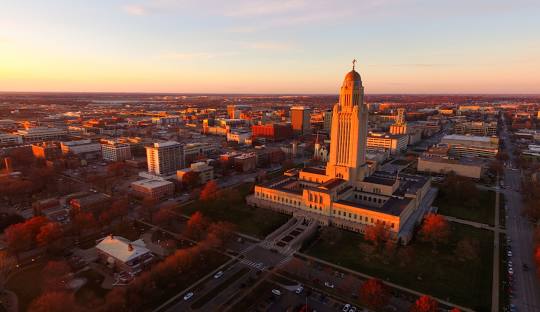
Overview
Project Leadership:
- Mayor Leirion Gaylor Baird
- Elizabeth ‘Liz’ Elliott, Director of Transportation and Utilities, City of Lincoln
Location: City of Lincoln
Focus: Multimodal infrastructure, economic mobility, and climate
Lessons Learned:
- Translate abstract visions into concrete plans
- Demonstrate local commitment to the project in a tangible manner
- Incorporate shows of support from community members and outside partners
- Seek feedback from federal agencies on grant applications
- Be persistent in continuing to pursue any and all applicable sources of funding
The Lincoln Multimodal Transit Transfer Center will include 18 bus bays (one for future intercity bus service), protected passenger boarding areas and walkways, waiting room, and administrative and safety offices for StarTran. The new, off-street facility will replace the current outdoor, on-street transfer center and will be more environmentally sustainable, including electric vehicle (EV) charging infrastructure to support fleet electrification.
The project is funded by a $23.6M RAISE grant; the local match is composed of the site’s land value of approximately $8M and $900K from local sources, including Lincoln’s Transit Capital Improvement Program.
Lincoln was awarded a RAISE grant in August 2022. Construction is slated to begin in 2024, and the project could be completed as soon as 2025.

Problem to Solve
StarTran, Lincoln’s city-owned bus transit provider, operates on a hub and spoke model, whereby a central transportation hub serves as the primary point for transferring between radial bus routes that go from the hub to various destinations. Lincoln’s current primary bus transit transfer point, the hub of the system, is an on-street location that has suffered from traffic congestion, poor pedestrian circulation, and other design challenges that delay bus trips. The location is undersized and not conducive to the safe and timely transfer of passengers between bus lines.
Because the current hub is undersized, StarTran has more fixed routes in its system than boarding/deboarding locations at the current transfer location, and as a result, StarTran has had to develop a network schedule that staggers arrivals/departures, creating longer transfers. Ideally, StarTran can have a ‘pulse’ transfer, whereby all routes converge at one time, enabling simultaneous transfers; this is important to fully leverage the efficiency benefits of a hub-and-spoke model. The staggered schedule makes transferring between routes confusing for passengers and causes inconvenient additional transfer time, up to 50 minutes, to daily trips. The capacity constraints of the location also limit StarTran’s ability to add new routes in the future.

The current hub does not have multimodal functions, or the capacity for such investments, whether it be improvements to intercity connections or local first/last mile connections, given the lack of space for bike or scooter storage facilities. In a support letter for Lincoln’s 2022 RAISE grant application, William Bivin, Statewide Mobility Manager at University of Nebraska at Omaha, noted that there are three intercity bus carriers providing daily service through Lincoln, two of which share a bus stop that is not located on a city bus route or convenient to lodging – posing a challenge as current intercity bus and Amtrak schedules often drop off and pick up between midnight and 6am in Lincoln.
Today, 10 of StarTran’s 67 buses are electric and 26% of the fleet is electric, hybrid, or alternatively fueled. StarTran continues to invest in fleet electrification and alternative fuels, with a goal of the entire fleet running on 100% electric, renewable, or alternative fuels by 2040, in line with Lincoln’s 2021-2027 Climate Action Plan. However, StarTran’s electric buses need rapid charging mid-day, so a charging- enabled parking solution is required to achieve the 2040 goal. Lincoln highlighted this aspect of the project in their most recent grant applications.
The current primary transfer location for StarTran does not have capacity for vendors or customer service staff who can address real-time concerns or facilitate on-site ticket sales. It is entirely outdoor with no indoor amenities or restroom facilities for riders or operators. Amenities are limited to two enclosed passenger shelters and benches under a building overhang, providing minimal shade and cover from precipitation. And, due to the shelter’s limited visibility from the street and the site’s inadequate lighting in the evenings, StarTran has had to contract off duty police officers to assuage riders’ safety and security concerns.
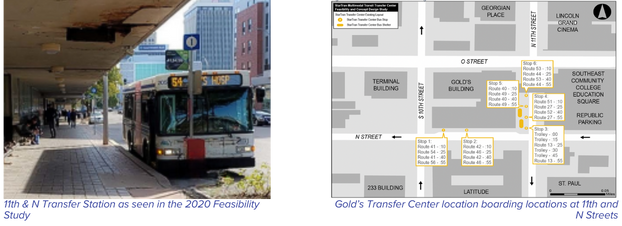
The site also lacks a break room or other amenities for bus operators, escalating challenges with employee retention which have further hindered route efficiencies. In the interim, the city has taken steps to strengthen its staffing levels. After seeing bus operator vacancies nearly double in one year, StarTran partnered with a marketing firm to produce a hiring event and campaign using bus, radio, and billboard advertisements. In just one event, StarTran was able to hire 20 new bus operators, drastically improving staffing levels.
Finally, StarTran’s administrative offices are located in a brownfield slated for remediation and reinvestment as part of the South Haymarket Park Redevelopment Site. The South Haymarket project will transform the brownfield site into a mixed use development, including up to 2,000 residential units and expanded commercial and office space. However, StarTran’s current administrative office location prevents developers from moving at full speed with the project.
These issues result in a transit network that is far from its potential efficiency and reliability. Mayor Leirion Baird, Lincoln Transportation and Utility Director Liz Elliott, and local leadership concluded a new Multimodal Transit Transfer Center (MTTC) was required to make StarTran an attractive, sustainable, and dependable option for residents’ daily transportation needs. The MTTC will address operator and rider concerns, improving the transit experience for riders and creating a better workplace for operators. Furthermore, the new MTTC will have space for StarTran’s administrative and security offices, allowing them to leave their current offices at South Haymarket so that the development project can advance.
Pre-Development
The MTTC project has been in development for almost 20 years, beginning with Lincoln’s first multi-modal feasibility study in 2004, which highlighted challenges at the existing transfer station given its exposed on-street, entirely outdoors location. Continued engagement with ridership and community members revealed that these challenges were a chief reason more residents were not utilizing public transit. From 2014 to 2022, the city made eight consecutive attempts for federal grant funding, through the Better Utilizing Investments to Leverage Development (BUILD) and Transportation Investment Generating Economic Recovery (TIGER) Discretionary Grants. Over the years, StarTran received repeated feedback along the lines of “you did well in the concept design, but [the application] did not prove technical progress, or [that the project was] shovel ready.” With this in mind, each year they continued to do more work in planning and preparing the project, taking steps that would take it, in Liz Elliott’s words, from a “back of a napkin type of thing” to a “strong enough, concrete vision… a plan that could be implemented.”
Beginning in 2016, the city began proactively setting aside funds for the MTTC via Lincoln’s bi-annual Capital Improvement Program (CIP), allocating $900K for the project’s local match component. That same year, the city made sure to include the MTTC in its annual transit plan and 2020-2021 long-range transit plan. Then, in 2020, Lincoln hired external consultants to produce a feasibility study to support their grant application. The feasibility study provided a new, updated “deep dive” into why Lincoln needed the MTTC, what benefits could be gained from it, and where it could be located.
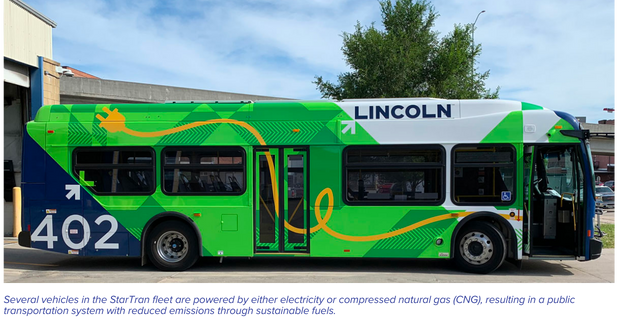
2022 RAISE Award
Building on years of grant applications to fund the MTTC project, StarTran adjusted the approach for the 2021 and 2022 grant applications, focusing more on building the narrative around how the MTTC would positively impact the Lincoln community.
For example, equity considerations were always a part of the project’s development, but prior federal grant applications did not prioritize related elements in scoring. As such, Lincoln’s TIGER and BUILD applications included only short mentions of the MTTC’s equity components. Then, with the Biden-Harris Administration’s announcement of the Justice40 initiative, StarTran knew they needed to demonstrate that equity considerations and impact were central to the project. They spent more time throughout the application showing how the MTTC would positively impact all 18 defined areas of persistent poverty in Lincoln by providing access to different neighborhoods in Lincoln and more work opportunities across the community. Similarly, they emphasized the environmental implications of the MTTC by showing its alignment with Lincoln’s long-term climate action plan, by bettering the transit network, and explaining the MTTC’s critical role in facilitating StarTran’s transition to a green fleet.

The city of Lincoln thought it was also important to highlight the ripple effects of moving StarTran administrative offices to the new MTTC, which supports the South Haymarket redevelopment, creating an additional economic benefit for non-transit users in the city.
Finally, for the 2022 RAISE grant application, StarTran and the city of Lincoln worked with their federal lobbyist to significantly increase their engagement with Lincoln’s federal representatives. Mayor Baird met with members of Nebraska’s congressional delegation to increase awareness of the MTTC project and ensure it had their support. StarTran worked with the lobbyist to review drafts of the 2022 grant application prior to submission, continuing to hone and focus its narrative throughout the process.
After building on lessons learned over the preceding years, Lincoln submitted their RAISE grant application for the MTTC for the eighth and final time in April 2022 and learned they would be a RAISE grant recipient in August of that year. Today, Lincoln is working closely with the Federal Transit Administration (FTA) on technical aspects of the grant as they formalize the award ahead of its disbursement. The award will provide the funding necessary to mobilize resources for the project and construction of the new hub, ending a 20 year journey from the initial feasibility studies in 2004 to a modern multimodal transportation hub, expected to be open in 2026. And, to maintain their new level of engagement with the state delegation, Mayor Baird and Liz Elliott have made a point to keep their Senators and Congressional Representatives briefed on the project’s updates whenever possible.
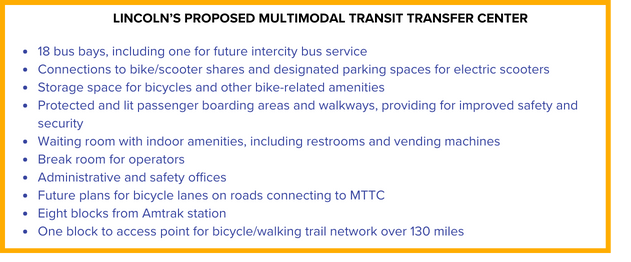
Partner Engagement and Support
Engagement with elected officials and stakeholders was a key component for project development and Lincoln’s successful grant application. At a local level, city officials played a key role. As cited above, Mayor Baird and Lincoln City Council members demonstrated their strong support by committing funds from the city’s annual budget through Lincoln’s CIP for the MTTC project. These funds went towards annual investments in planning components and set asides for future construction. These commitments were integral in organizing the local match, strengthening Lincoln’s application. Mayor Baird also provided a letter of support for the 2022 RAISE application, making a strong and compelling case for the impact that the MTTC would have on Lincoln.
The Lincoln Metropolitan Planning Organization showed the regional impact of the city’s project, noting how it supports the Lincoln MPO 2050 Long Range Transportation Plan, by providing a high level amenity for bus riders, bicyclists, pedestrians, and other transportation providers.
Given that the proposed site is a joint city-county property, and near the county’s offices, the city has engaged closely with county-level partners to illustrate the shared commitment to transit improvements, the project, and their consensus on the usage of the jointly owned property. Deb Schorr, Chair of the Board of County Commissioners for Lancaster County, signed a support letter for the RAISE grant application, noting their belief that the project would support “the County and the City’s shared interests in providing efficient transportation to better serve the demands of [a] growing City and County, to provide connectivity to the greater region along with enhanced parking for [their] guests and workforce, and to support economic opportunity across the community.”
University of Nebraska at Lincoln (UNL) has a contract with StarTran where StarTran provides intra- and inter-campus routes Monday through Friday during fall and spring semesters. University staff and students can use the transit service free of charge. UNL sent a letter of support for the RAISE grant application, laying out their commitment to the project given that the institution’s and city’s growth demanded stronger transit connections.
The Lincoln Chamber of Commerce and Lincoln Partnership for Economic Development also wrote a support letter, noting that the MTTC “will help support two decades of $1.53B of private and public investments in the downtown area.”
The Center for People in Need (CPN), a private, nonprofit dedicated to providing services and programs to low-income people that address their basic needs and help them achieve economic independence, illustrated their commitment to the project in a support letter. They noted the need for a new transit transfer center, identifying challenges with the existing hub related to safety, lack of onsite ticket sales, and unreliable timings.
With the emphasis on the clean energy transition in the Biden-Harris Administration, StarTran wanted to highlight how their new multimodal transit center fits into their broader citywide climate action plan. Specifically, the new transit center would support fleet electrification by providing space where buses could charge midday, enabling electric buses to be used for all regular services. StarTran engaged Lincoln Electric System, the municipal-owned electric utility, to support the fleet transition and necessary infrastructure upgrades. In-line with StarTran’s 2040 goals for transitioning their fleet to electric or alternative fuels, StarTran and Lincoln Electric are discussing future collaborations for other IIJA programs such as the FTA’s Low-No Emissions Bus Program and the FHWA’s Charging and Fuel Infrastructure Program.
Community Engagement and Impact
Community Engagement
Throughout the project pre-development and grant application processes, StarTran has been intentional in their community engagement efforts and strategy. Liz Elliott, Director of Transportation and Utilities for Lincoln, attended the Bloomberg Harvard Civic Engagement Program*, providing her with new tools for public engagement and enabling her to break from the traditional, less-effective approaches. In Liz’s words, humoring the “old” form of community engagement, she remarked “I’m the government, [and] I’m going to come speak at you [to] tell you this is a good idea.” Elliott’s biggest takeaway from the Harvard program has been the importance of investing time and energy into smaller events rather than hosting a few large, public open houses. Elliott noted that they are being more intentional about doing stakeholder mapping to ensure that nobody is being left out of the discussion.
Under Elliott’s leadership, for example, StarTran is working to engage people who would not usually show up to a community meeting. Instead they are meeting residents where they are, such as neighborhood cultural centers. Elliott and her team garnered further insights about the unique challenges facing non-native English speakers who may be overwhelmed by the transit system. Lincoln is home to over 30,000 refugees from across the globe, with 55 different languages spoken throughout the city. This has spurred them to think about how to make StarTran more welcoming for all residents and help them to utilize the transit services more.
“That might mean I have to do 10 different presentations or meetings and discussions, but we think that would be a valuable investment to really hear from the people” -Liz Elliott, Director of Transportation and Utilities, City of Lincoln
As part of the engagement process, in addition to several online surveys, StarTran employees and consultants engaged regular riders on buses and at bus stations to learn more about what they want to see in the transit network and a new transfer center. These efforts shed light on the biggest concerns of riders, which mainly related to safety and lengthy transfers.
StarTran also sought input from non-riders by engaging with stakeholder groups, including the Lincoln Chamber of Commerce, minority communities, and local residents, to leverage their networks for further feedback and to generate new ideas to make StarTran a more attractive transportation option. Their engagement with impacted businesses, both near the current and future transfer center, has allowed StarTran to identify potential changes and service adjustments to ensure that customers can still access those businesses and support new local businesses, both during construction and long-term. Beyond these groups, Liz Elliott noted that they are also engaging with a residential community adjacent to the site of the MTTC to address neighborhood concerns related to light and noise pollution and loitering.
Community Impact
A 2020 Benefit-Cost Analysis (BCA) commissioned for the MTTC’s 2020 BUILD grant application found that the facility “will accommodate a suite of mobility services… [promoting] a network of non-automotive transportation in Lincoln, expanding access to employment, social, and recreational opportunities to a broader swath of the regional population of all ages and abilities.” The updated BCA found that the project would yield a benefit-cost ratio of 1.2, meaning that every dollar spent on the project would yield $1.20 in benefits. Over the 30 year analysis period, the project would yield total benefits of $20.3M.
As a facility designed for pulse operations with a fixed-route system, the MTTC will accommodate buses on all routes at once, rather than in waves, providing for efficient, reliable, and coordinated transfers for passengers. Thus, bus passengers will see reduced travel times. Further, the MTTC will provide indoor seating and restrooms, giving passengers and operators shelter from the elements that the current, on-street transfer center cannot provide. The relief and amenities provided in the MTTC for operators will support StarTran’s efforts to hire and retain employees, especially considering the lack of amenities for bus operators on their routes. In addition to increased safety at the new MTTC, due to its off-street location and the presence of additional lighting and security offices, these benefits will encourage more transit trips in Lincoln, fostering a decrease in automobile usage and thus in emissions from cars. The new facility will also support StarTran’s fleet electrification by providing charging infrastructure, furthering their work towards the 2040 goal.
The MTTC is expected to generate further economic development in the area through transit-oriented development and mixed-use developments. Already, there are several apartment complexes for students and others being built in the immediate vicinity within one or two blocks of the MTTC. The community will also benefit from the continued interest in developing South Haymarket and remediating a current brownfield. The MTTC project also fits within the University of Nebraska’s long-term masterplan given their relationship with StarTran. Elliott noted that they want to hone in on these groups of new residents to attract them to the transit network.
The Center for People in Need’s (CPN) support letter noted the impact of the MTTC project on low-income populations, highlighting the fact that these transit investments would lead many of their customers to self-sufficiency:
“The time is ripe to build the MTTC because downtown Lincoln has the highest density of jobs available in the city. Using public transit enhanced with a new, high-functioning multimodal transportation center would lead many of CPN’s customers to economic self-sufficiency.” -Chris Funk, Executive Director of CPN
Finally, Lincoln’s 2020 Benefit-Cost Analysis recognized the successes of transit centers in peer Midwestern cities, such as Des Moines, IA; Sioux Falls, SD; and Springfield, MO, where new facilities have allowed the initiation of “more efficient ‘pulse operations’ with safer, element-protected transfer areas, while adding additional community benefits such as new businesses, park-and-ride spaces, and bicycle facilities.”
Site Selection
Lincoln’s site selection was driven by several geographic factors, including current rider origin and destination points, as well as gaps in underserved communities more likely to utilize public transit. Since the start of the Justice40 initiative, Lincoln has sought to highlight the fact that the proposed sites are within the same designated Climate and Economic Justice census tracts.
Lincoln’s original site, an old police station, was disqualified through the National Environmental Policy Act (NEPA) Review Process, which identified its prior use as a gas station and would complicate development and increase costs due to its underground gas tanks.
Lincoln subsequently proposed a site on the same block that is home to a parking structure for city and county employees working at an adjacent building. The site was designated in their 2022 RAISE grant application despite city concerns that it is surrounded by four busy arterials, worsening traffic congestion and creating safety concerns. Replacing the parking structure at this site would cost an additional $16M, according to Elliott. While the city considered shrinking the site to maintain parking, the FTA had concerns given that, in their RAISE application, StarTran proposed the full city block for the project. Given these concerns, the city identified a third site on a surface parking lot for city and county employees, that would only cost $6M to replace, with no existing structures, only two arterials, and less potential for traffic congestion. Because the third site has a comparable land value, they have been able to work with FTA to make the switch.
Project Funding
The project is funded by a $23.6M RAISE grant, awarded to StarTran in 2022. The required local match consists of the city-county owned property, valued at approximately $8M, in addition to $900K from Lincoln’s CIP.

Conclusion
Lincoln’s Multi-Modal Transit Transfer Center was first conceptualized in 2004 and went through seven (7) unsuccessful application processes before finally receiving RAISE funding in August of 2022. Through persistence, thoughtful listening, and trust-building with local, state, and federal partners, Lincoln continuously improved upon the MTTC concept and developed a comprehensive, equity-driven solution for their transit operators and riders. Local leaders like Mayor Leirion Baird and Transportation and Utility Director Liz Elliott prioritized community engagement to guide their approach and ensure that all of their residents could feel comfortable and safe using StarTran’s services. As they move into implementation, StarTran is continuing their public engagement efforts, and construction is set to begin in 2025. The project is expected to be complete by 2026.
The benefit-cost analysis anticipates that the project would attract new riders to the system “beyond baseline ridership growth because the MTTC will provide shorter transfer times and needed amenities.” The original BCA estimated 1.8M hours in saved travel time, the result of a 15-17% reduction in total travel time. Over the projected 30 year analysis period. The new MTTC, due to anticipated growth in transit demand, is estimated to result in a substantial reduction of over 3.6M vehicle-miles traveled, resulting in reduced emissions from personal vehicles. Over this period, the project will also save over a million hours of travel time.
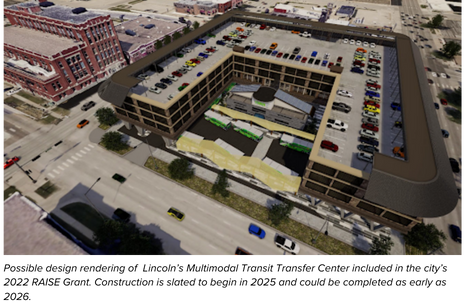
Accelerator for America would like to thank Drexel University Nowak Metro Finance Lab for their partnership in production of this case story for the Local Infrastructure Hub.



